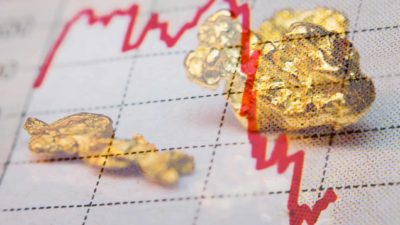S&P/ASX 200 Index (ASX: XJO) gold shares have delivered some super-sized returns over the past six months.
The big gold stocks, and indeed many of the junior miners and explorers, have benefited from a fast-rising gold price.
Bullion, a classic haven asset, has been on a tear since November amid ongoing geopolitical uncertainties, sticky inflation in the world's top economies, and global recession fears, among other factors.
Indeed, gold has managed to deliver positive returns in five of the last seven recessions.
On 7 November gold was trading for US$1,676 per ounce. Today that same ounce is worth US$2,017. That's up 20% in just six months and fast approaching new record highs.
How have ASX 200 gold shares performed?
As you'd expect, a 20% surge in the price of the yellow metal they dig from the ground has been a boon to ASX 200 gold shares.
Over the past six months the S&P/ASX All Ordinaries Gold Index (ASX: XGD) – which also contains some smaller gold stocks outside of the ASX 200 – has surged 51%. That compares to a six-month gain of 4.5% posted by the ASX 200.
As for some of the top Aussie gold miners, here's how they've tracked over the six months:
- The Regis Resources Ltd (ASX: RRL) share price is up 39%
- The Northern Star Resources Ltd (ASX: NST) share price has gained 48%
- The Evolution Mining Ltd (ASX: EVN) share price has leapt 82%
- The Gold Road Resources Ltd (ASX: GOR) share price is up 39%
I don't think you'll hear many shareholders complaining about those returns!
Of course, these gains have all been banked.
The big question now is, can ASX 200 gold shares continue to outshine the benchmark?
What's next for the gold price in 2023?
The first quarter Gold Demand Trends report from the World Gold Council, released on Friday, reveals a mixed picture for Q1 but indicates a potentially strong year ahead for bullion and ASX 200 gold shares.
On the negative side of the ledger, demand in India, the world's most populous nation, fell steeply over the quarter. That was driven by record-high gold prices in Indian rupee terms, which impacted both investment and jewellery consumption during the quarter.
Gold-backed exchange-traded funds (ETFs) also recorded a modest 29 tonne outflow over the quarter. Though that trend reversed in March with renewed ETF inflows as investors turned to the haven asset amid the US banking crisis.
On the plus side for the outlook for gold demand – and by connection ASX 200 gold shares – central bank appetite for bullion remains voracious.
According to World Gold Council, central banks added 228 tonnes of bullion to their reserves. That's a record amount for the first quarter.
"Against the backdrop of turmoil in the banking sector, ongoing geopolitical tensions and a challenging economic environment, gold's role as a safe haven asset has come to the fore," said Louise Street, senior markets analyst at the World Gold Council.
Street added:
In this landscape, it is likely that investment demand will grow this year, especially with waning headwinds from the strong US dollar and interest rate hikes. Positive demand for gold ETFs has continued in Q2 so far, and the looming threat of developed market recession may be the trigger for inflows to accelerate later in the year.
Central bank buying is likely to remain strong and will be a cornerstone of demand throughout 2023 – even if at lower levels than the record highs seen last year.
Should bullion demand indeed remain resilient, ASX 200 gold shares are well-positioned to keep outperforming.









